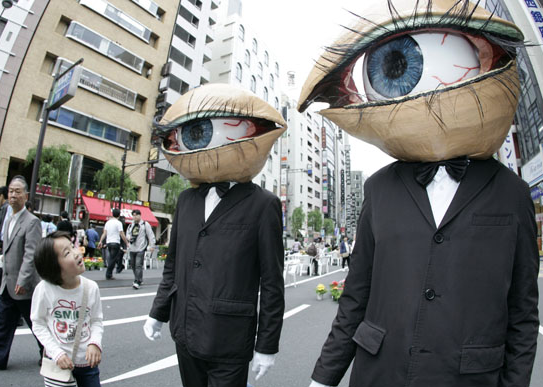
Walking and perceiving, preferrably optically, stand out as the main acts of flaneurhood. Many testimonies bear witness to the flaneur as being one of urbanity's most well-known psychosocial types: Baudelaire, Benjamin, Simmel, de Certeau, Debord etc. The flaneur is a rather delicate and sometimes distant character that strolls through urban realms; Henry Miller creating a smooth space while loitering around in Brooklyn, as Deleuze and Guattari remind us.
In his conceptualization of parkour, Michael Atkinson timely interprets the traceur as a late-modern flaneur. While the modern flaneur was 'sketching' a space for himself (yes, unfortunately, this is just another persona based on an initially, and still hegemonically, male praxis), in which he could 'read' the city, Atkinson conceptualizes the late-modern variety as being capable of Heideriddean deconstruction. The void between houses, sous rature, becomes a

avoid falling down
It's inadequate to conceive of the opposite sides of a void as incommensurable, but it's necessary to stress that there is a gap, and that it takes a leap of faith to cross it. Association. Tracing is a micropolitically informed sociology. Life and live in HypheNation. Furthermore, concerning the flaneurie of traceurie, it seems that Deleuze and Guattari's distinction between smooth and striated space could enrich Atkinson's attempt to grasp parkour.
In sketching (tracing) space, the flaneur uses only the utmost tip of his body-brush: the soles of his shoes. The rest of the body is busy with an array of repetitive bodily idiosyncracies, such as smoking, walking casually, nodding, and tipping his hat at attractive and interesting passersby. The difference he makes is not to be found in these simple schemata, in this endless repetition, but in his interpretetive gaze. The optic reading of the city is the prime power of flaneurie. Compared with that, the bipedal itinerancy and meanderings of flaneurs appear as quite lame performances.
Deleuze and Guattari label the city "the striated space, par excellence", and by striation they mean the creation of channeled and hierarchical space, so that movement, in it, is rendered predictable. Striation, as the cybernetics of displacement, is the ordering of identities and positions onto grid-like fields, that are easily surveyed. In striated space, vision and optics therefore have a primacy. This of course relates to Foucauldian panopticon. One might even assert, that, as cities grew more and more entangled, more rhizomatic, and therefore more hard to overview, the proliferation of flaneurs served as a "necessary" distribution of surveillance. Big brother tips his hat at you. Male Gaze, and all that.
The traceur puts a different approach on display as he connects haptically, and not primarily optically, with the the city. The optic primacy of striated space, in smooth space, is inversed to a haptic primacy. A heightened hapticity, is the tactilization of (all) the senses. Although a loosely standardized and sketchy one, the repertoire of movements of traceurs often bear names that are lend from different agile species in the animal kingdom, such as cats and monkeys. And this should not primarily, as Michael Ferrari's analysis might imply, be interpreted as a search for an alleged pristine and savage nature of mankind. Rather, the quadropedal style of traceurs is functional-experimental. In parkour one does not mimic a animal, one is, as Deleuze and Guattari would have it, becoming-animal. One dialect of Agamben's gestural communication in the 'coming community' could definitely be taught by traceurs.

Being a late-modern flaneur, the traceur grasps and embraces his surroundings, rather than putting them on the hermeneutical treadmill. As a philosophical stance, then, tracing is kin to the musings of Bergson, when he -- by way of intuition, rather than through conceptual clarity -- attempts to melt into the phenomena under investigation. Whereas the flaneur perceived and interpreted the monstrosities of urbanism, the traceur conceives the city, in all its denotations; demonstration. Monstrare means 'to show', and -- although tracing might be perceived by pedestrians (modern flaneurs perhaps) as a spectacle -- a show is primarily seen, in that it evokes vision. Monsters are seldom felt; the moment when the monster will reveal itself is always the climax (equivalent to the climax when it is defeated). Once in a while even a monster needs a hug.
And that, is what traceurs do: hug monsters.
No comments:
Post a Comment